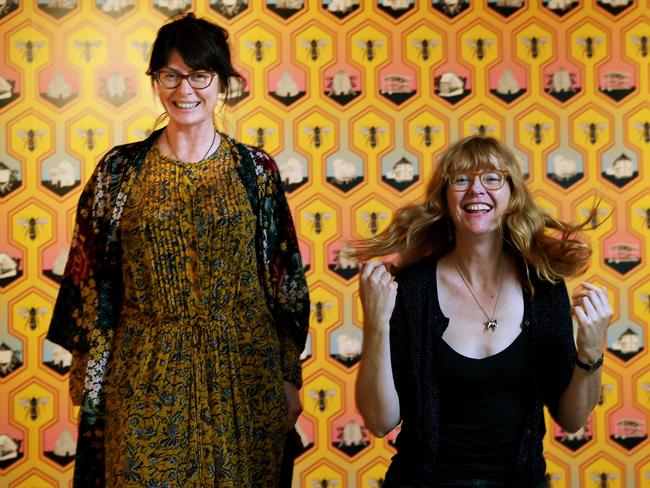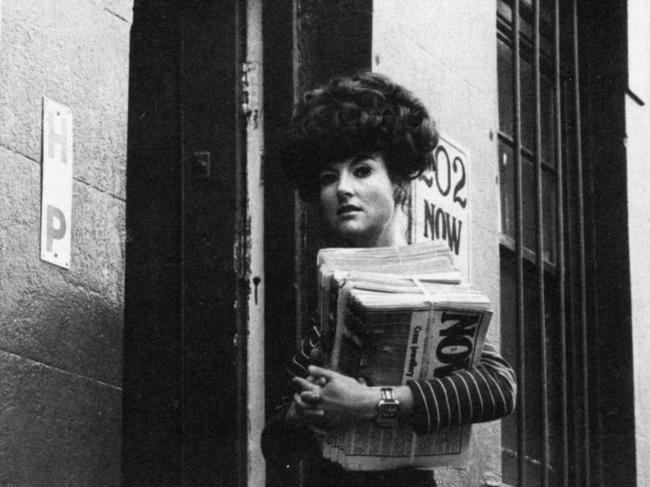The murder of glamorous style icon Juanita Nielsen is the focus of The Beehive, part of the Sydney Festival
Why did Juanita Nielsen have to die? The Beehive looks at the cold case of this journalist, style-icon, heiress and activist.
Why did Juanita Nielsen die? This is the cornerstone of the installation The Beehive that restores journalist, style-icon, heiress and activist to a symbol of the fight against the gentrification of inner-Sydney.
It is a fight against what this experimental video, part of the Sydney Festival, characterises as “development fast and violent”. And it is a fight that she died for.
The work explores the unsolved murder of Nielsen who campaigned against the violent eviction of tenants on Victoria St at Kings Cross.
She disappeared on July 4, 1975 after a business appointment at the Carousel Cabaret night club in Kings Cross. More than 40 years later her body has never been found and no one has been charged.
Artist Zanny Begg and creative producer Philippa Bateman weave the tropes of this true crime story with themes of gentrification, corruption and non-conformity in The Beehive that is now on show at UNSW Galleries.
“I spent about a year researching the cold case of Juanita Nielsen.” Begg said,
“The project is driven by an algorithm so there is more than 1334 different variations, which speaks to the ambiguity surrounding the case, we don’t exactly know what happened to her though, I think, it is fairly clear and the clues are all there.
“Each episode is different and runs between 22 and 33 minutes and once you watch a couple there is enough clues. It is pretty clear, maybe not who pulled the trigger, but who wanted it to happen.”

This is the first time the video installation has been seen in Sydney, and it is being shown just a few streets from where she was last seen alive.
The installation is accompanied by memorabilia around her disappearance, as well as a public program of talks and events inspired by her story.
The film is ever-changing, as the footage is randomly selected for each screening with 1,344 possible variations, offering different glimpses and interpretations of this infamous true crime. The artwork presents a kaleidoscopic portrait of Nielsen with multiple actors playing the lead role, including Wentworth star Pamela Rabe.
“I hope it speaks to not just what happened in 1975 but also about Sydney today, looking at issues of affordability and housing justice,” Begg said.
“Juanita was this incredible figure who cared about this issue and gave her life trying to defend low-income housing in the inner-city.”
“She believed a place like Kings Cross should be a place for everyone rather than just being a place for the extremely well-heeled.”

Begg said the original concept for the work was to build an algorithm around the different theories about who might have committed this notorious murder but the more she learnt about Nielsen the more she wanted to explore the woman herself.
“I realised she was such an interesting character so the final work gives more insights into this incredible style icon and fashionista with the beehive and mod clothing,” she said.
”She was all that but she was also this really staunch union activist who was friends with Jack Mundy and was involved in pioneering the Green Bans.
“She was a real rebel. She believed in open relationships and had multiple lovers. She spoke six languages and was highly intelligent. She travelled a lot. She was a very open minded, non-conformist human.
“Meeting her partner at the time she vanished, David Farrell, was really significant for me.
“He was 14 years younger then her. They were together for seven years. He was only 24 when she vanished and it was quite hard to find him. He had been quite private for a long time. But we connected and he really loved the way I wanted to tell the story so he was happy to collaborate. He is interviewed in the film.”

UNSW Galleries director José Da Silva says this was a uniquely Sydney story: ”Zanny Begg’s work speaks to the enduring issues of housing affordability and development in Sydney, violence against women, trade union activism and policing sex work. We are thrilled to be creating a public platform for these issues to be discussed, as well as continuing the push for justice in the Juanita Nielsen case”..
The exhibition is accompanied by a public program series exploring themes inspired by the story of Nielsen. The Radical Sydney series takes its name from Terry Irving and Rowan Cahill’s 2007 book on dissident politics and actions in Sydney.
The program of talks, documentary screenings and performances focus on local activism concerned with housing, public space, sexuality and gender.
Highlights include a walking tour of East Sydney and Kings Cross with sex worker rights activist Julie Bates; a talk on the significance of alternative club culture in Sydney; discussions on the legacy of the 1970’s Green Bans; and screenings of Rocking the Foundations (1985) and The Eviction (2018) with filmmakers Pat Fiske and Blue Lucine.
EXHIBITION DETAILS
Where: UNSW Galleries
Address: Cnr. Oxford St and Greens Rd, Paddington
When: Until February 23, 2019
Tuesday – Saturday, 10am-5pm (closed public holidays)
Tickets: Free
Public Program: Radical Sydney runs until February 23
Website: artdesign.unsw.edu.au/unsw-galleries


